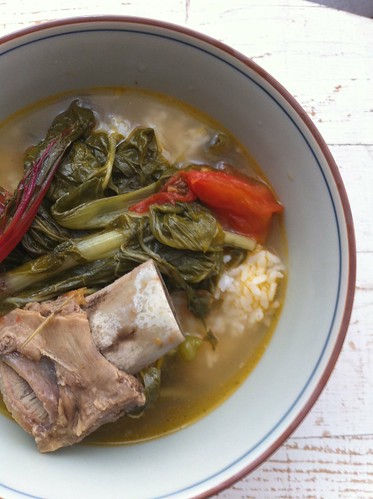In Michael Pollan’s latest book, In Defense of Food, he summarizes his lecture on the first page: Eat food. Not too much. Mostly greens.
I love greens, but I also love all kinds of meat. And you know how I feel about bacon, right? But there are days when I do crave vegetable-only dishes. I run to Joe’s Shanghai for their baby bok choy flash-fried in garlic and hot oil. I go to Snack for their artichoke salad sans the chicken. Sometimes, I even go to my local deli’s make-your-own-salad counter and pick from the available ingredients just to get my fix. And when I eat my meat, there’s always a side that involves a vegetable.
You can use almost any kind of greens here. I used Chinese spinach because that’s what I had in the fridge. Regular spinach, watercress or bok choy will do, too. They key is to simmer everything for a long time, so that the broth thickens with all the carrot and celery goodness. You’ll get more of the lentils’ earthy taste in the end. If you can deal with the extra work, use a hand blender and purée the entire batch before serving.
When they’ve cooled down, transfer leftovers in quart containers and store in your freezer for up to two weeks. You can just thaw and heat one up when you want another serving of hearty lentil soup.
2 1/2 cups of lentils, rinsed
4 stalks of celery, chopped
1 bag of baby carrots, halved
1 bunch of greens
vegetable broth
1 tomato, quartered
1 red onion, thinly sliced
2 cloves of garlic, minced
1 tbsp of coriander, toasted, grounded
1 tbsp of cumin, toasted, grounded
1 tbsp of cardamom, toasted, grounded
salt, pepper, oil1. In a large Dutch oven, heat some olive oil. Sauté garlic and onions. Add the carrots and celery and cook until glistening, about 8 minutes. Add the lentils, tomato and the spices to combine. Add enough broth to cover.
2. Bring to a boil and then reduce heat. Cover and simmer until lentils are tender, about 40 minutes to an hour. Season with salt and pepper before serving.
Related post/s:
Buy Michael Pollan’s latest book, In Defense of Food
A very easy tomato bread soup






